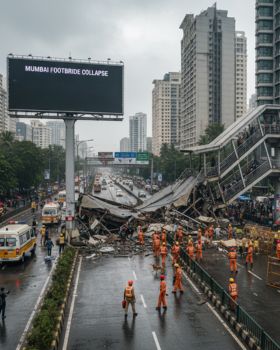
Disclaimer:
This blog post is intended for informational and educational purposes only. The analysis of the Hyatt Regency walkway collapse is based on publicly available records, reports, and case studies. It is not intended to assign blame or speculate on legal responsibility for the incident. The purpose of this content is to reflect on the lessons learned and highlight the importance of safety, communication, and contractor management in construction projects. All references to modern contractor management tools are made in the context of discussing current best practices and do not imply that such tools could have definitively prevented past events. Readers are encouraged to consult qualified professionals for specific advice related to engineering, construction safety, or compliance.
The Hyatt Regency Walkway Collapse remains one of the most tragic structural failures in U.S. history. On July 17, 1981, during a lively dance event at the Hyatt Regency Hotel in Kansas City, two suspended walkways suddenly collapsed, killing 114 people and injuring over 200 others. This catastrophic event has since become a pivotal case study in engineering, safety, and project management across the world.
Understanding the Factors Behind the Hyatt Regency Walkway Collapse
In the wake of the collapse, investigations revealed that a series of design modifications, communication gaps, and insufficient oversight contributed to the walkway failure. One of the most significant findings was that a design change during construction inadvertently altered the load-bearing dynamics of the walkways.
Originally, the walkways were intended to be supported by continuous steel rods running through both structures from the ceiling. However, during the fabrication phase, this was altered to use two separate rods — one for each walkway — for ease of assembly. This modification doubled the load on the upper walkway’s support beams, and unfortunately, this increase went unnoticed during the review process.
The incident is often cited not simply as an engineering failure, but as a failure of coordination, documentation, and quality control between the various teams involved in the project.
Communication Gaps and Oversight Challenges
One of the most critical elements that contributed to the disaster was the breakdown in communication between designers, contractors, and fabricators. The revised design was not subjected to a full structural review, and the approval process lacked sufficient checks and documentation.
At the time, manual and paper-based systems were the industry standard. While widely used, such methods were inherently vulnerable to human error, miscommunication, and misfiled records — conditions that can allow dangerous oversights to go undetected.
The Role of Contractor Management in Ensuring Construction Safety
Although modern contractor management software did not exist in 1981, the principles of safety oversight, clear communication, and design review were as important then as they are today. With multiple teams often working simultaneously, the need for a centralized system of documentation, accountability, and communication is critical.
Modern platforms could help reduce risks in today’s projects by offering:
- Controlled documentation systems
- Transparent communication channels
- Clear audit trails and accountability
- Real-time visibility into contractor tasks and design approvals
To be clear, no software can guarantee absolute safety. However, tools that improve transparency and process rigor could help reduce the likelihood of missteps by ensuring that every change is tracked, reviewed, and documented appropriately.
Engineering Lessons That Still Resonate Today
The Hyatt Regency disaster has profoundly influenced the way we approach structural design, quality assurance, and risk management. In today’s world of advanced tools and stricter safety regulations, the key lessons from this tragedy remain critically relevant:
- Avoid implementing design changes without a formal structural review
- Ensure open and documented communication between all stakeholders
- Maintain rigorous contractor qualification and oversight processes
- Prioritize safety and engineering integrity over speed or cost
Could Today’s Contractor Software Help Reduce Risk?
While we cannot speculate on how different the outcome might have been, it’s worth considering how modern contractor software could assist construction teams in better managing complexity and improving collaboration.
Contemporary contractor management platforms provide capabilities such as:
- Centralized document control
- Structured design change approval workflows
- Digital contractor onboarding and safety inductions
- Access to real-time information on qualifications, permits, and safety documentation
These features are designed to support project teams in reducing miscommunication, improving traceability, and strengthening compliance with regulatory and safety standards.
A Note on Responsible Reflection
It is essential to remember that the Hyatt Regency walkway collapse was a human tragedy. This article reflects on the incident not to assign blame or speculate on legal responsibility, but to underscore the importance of rigorous safety practices and communication protocols in construction. The event remains a sobering reminder of what can go wrong when crucial checks are missed — and what must be done to prevent similar occurrences in the future.
Moving Forward: Building Safer Sites with Better Tools
The Hyatt Regency collapse left a lasting mark on the engineering and construction industries. In its aftermath, building codes and project oversight standards were updated, and the need for improved coordination became undeniable.
Today, with the help of the best contractor management software, organizations have access to tools that support safer work environments, increase accountability, and streamline documentation. While these platforms cannot prevent every issue, they can play a critical role in helping teams detect risks earlier, track changes responsibly, and foster better project-wide communication.
Explore How SHEQ Network Supports Safer Contractor Management
At SHEQ Network, we provide contractor management solutions designed to help construction and engineering firms stay compliant, organized, and safe. From digital inductions to real-time permit tracking, our tools aim to bring clarity and control to complex operations.
📞 Contact us today to discover how our platform can support your safety goals:
📧 info@sheqnetwork.com | 📞 +353 21 4536034
🔗 Learn more at sheqnetwork.com
📅 Ready for a personalized demo? Book your session here
Let’s build a safer future — together.



